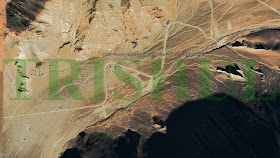As per an agreement inked between
Mauritius and India on March 11, 2015, the latter had committed to funding the construction
of an airport capable of accommodating twin-engined jetliners as well as
LRMR/ASW platforms like the Indian Navy’s P-8I. As of now, construction of the
runway is nearing completion, along with an apron capable of housing two P-8Is (on periodic deployments) at a time.
A similar agreement had been
inked on June 26, 2018 between Seychelles and India under which a similar
facility was to be built at the former’s Assumption Island. However,
construction has yet to begin.
Such far-flung facilities are
required to keep tabs over the underwater trenches where hostile SSBNs will likely be deployed
for launching SLBMs against Indian targets in the western, central and southern
hinterlands.

In February 2018 India secured
access to the Port of Duqm in Oman for military use and logistical support
by/for the Indian Navy. This was one of the key takeaways of Prime Minister
Narendra Modi’s two-day visit to Oman, where he met the then Sultan of Oman,
the late Sayyid Qaboos bin Said Al Said. An annexure to the Memorandum of
Understanding on Military Cooperation was then signed between the two
countries.
Following this, the services of Duqm Port and its dry-dock
have been available for maintenance of Indian Navy warships. In September 2017,
the Indian Navy sent a Class 209/Type-1500 SSK to this port along with the
Project 15 DDG INS Mumbai, plus two P-8Is to the nearby Duqm Airport.
The MoU on Military
Cooperation was signed in 2005 and renewed in 2016. This has provided the
general framework to strengthen bilateral military cooperation ties. On the
other hand, the MoU on cooperation in maritime security between Coast Guards of
the two countries, signed in May 2016, has provided a firm foundation for
deepening institutional interactions.
Also, the ongoing UAE-financed
airport construction activities at Yemen’s Perim Island in the Bab El Mandeb Strait, and at Socotra Island to the east, have the
potential of turning these navigational choke-points into strategic SIGINT
stations that can be assessed by the Indian Navy.
Another potential chain of ISR
outposts can be created in the Comoros group of islands.
But the most critical cooperation of a trilateral nature (involving the US, India and Oman) has been in the arena of undersea warfare.
This involves the setting up of a US-funded
and owned SOSUS network of seabed-based hydrophone arrays that begins from
Diego Garcia and stretches northward via Seychelles all the way up to Oman’s
Masirah island, and from there to coastal Porbandar in Gujarat, terminating at
an onshore forward operating base (FOB)—INS Sardar Patel—which was commissioned
on May 9, 2015 in Porbandar.
Supplementing this FOB is another upgraded FOB at
Mandvi, plus a storage-cum-launch complex for BrahMos-1 supersonic multi-role
cruise missiles at the Indian Air Force’s Naliya AFS.

































